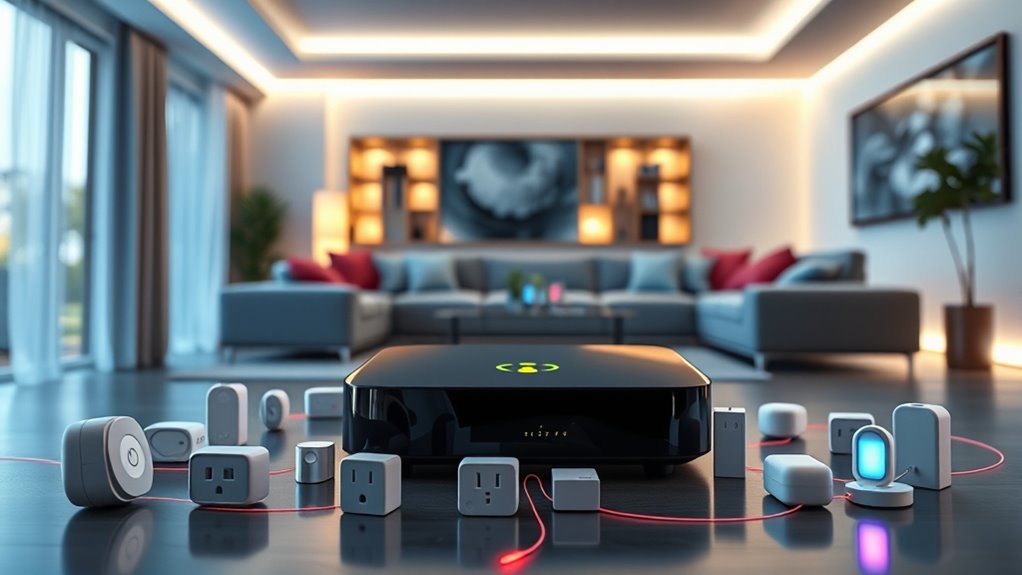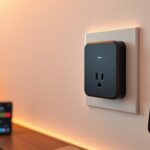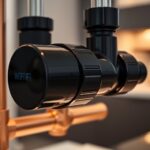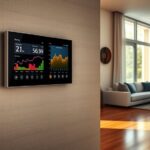If you want seamless Zigbee connectivity in 2025, I recommend exploring hubs like the Aqara M3, HomeSeer Pi G8, and AduroSmart ERIA, which support multiple protocols and offer robust device compatibility. These hubs provide local control, strong security, and easy integration with popular platforms like Alexa and Google Assistant. Whether you’re looking for multi-protocol flexibility or a simple setup, there’s a solution that fits your needs. Keep going, and you’ll discover the best options for your smart home.
Key Takeaways
- Choose multi-protocol hubs like Aqara M3 or Smart Multi-mode Gateway for broad device compatibility and seamless integration.
- Prioritize hubs supporting local automation and encrypted storage for enhanced privacy and quick responsiveness.
- Consider hubs with Wi-Fi, Zigbee, Thread, and Z-Wave support to ensure reliable connectivity across various devices.
- Opt for hubs compatible with popular ecosystems like Alexa, Google Assistant, and Apple HomeKit for effortless control.
- Evaluate device limits and scalability to match your home’s size and future smart device expansion needs.
Shelly Pro 4PM Wi-Fi & LAN Smart Relay with Power Metering
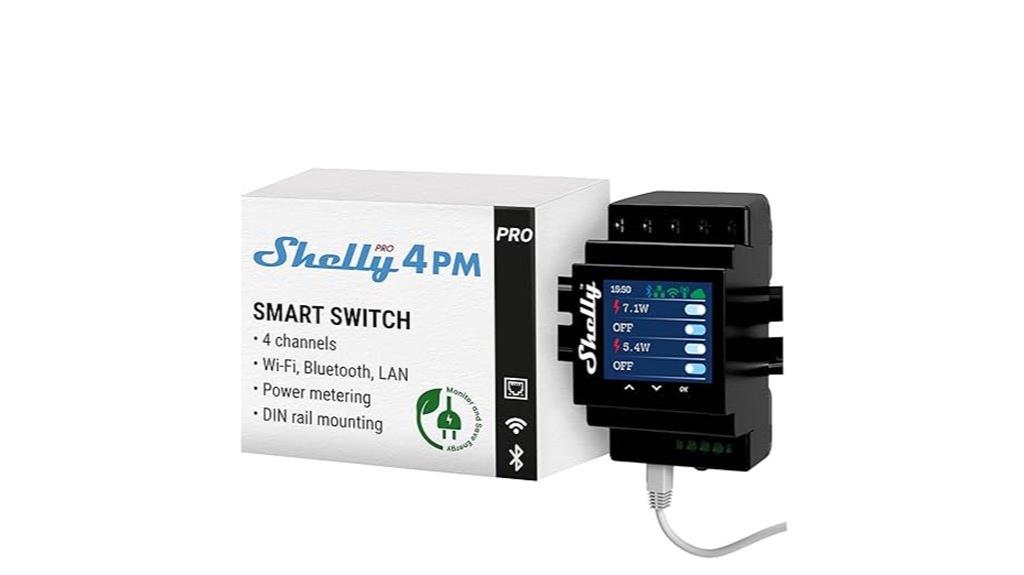
If you’re looking for a reliable way to monitor and control your home’s energy consumption, the Shelly Pro 4PM Wi-Fi & LAN Smart Relay is an excellent choice. It’s a single-phase, four-channel relay that supports both LAN and Wi-Fi, making setup straightforward. Each channel handles up to 16A, with a total capacity of 40A, and features four precise power meters for independent energy monitoring. Designed for DIN rail installation, it offers load protection and integrates seamlessly into smart home systems. Its automation features, scheduling, and scripting capabilities let me control appliances, lights, and more remotely or automatically, enhancing energy efficiency and convenience.
Best For: homeowners, DIY enthusiasts, and small businesses seeking reliable energy monitoring and automation solutions for their electrical systems.
Pros:
- Supports LAN and Wi-Fi connectivity for flexible setup and remote control
- Four independent power meters for precise energy consumption monitoring
- Designed for easy DIN rail installation with load and surge protection
Cons:
- Lacks normally closed/dry contact options, limiting some automation scenarios
- The device feels lightweight and plasticky, with wiring terminals that could be sturdier
- Wattage monitoring may be less effective when controlling high-current loads through multiple relays
Hub Mini Smart Home Hub (Compatible with Alexa, SmartThings, Philips Hue, Nanoleaf, Govee)
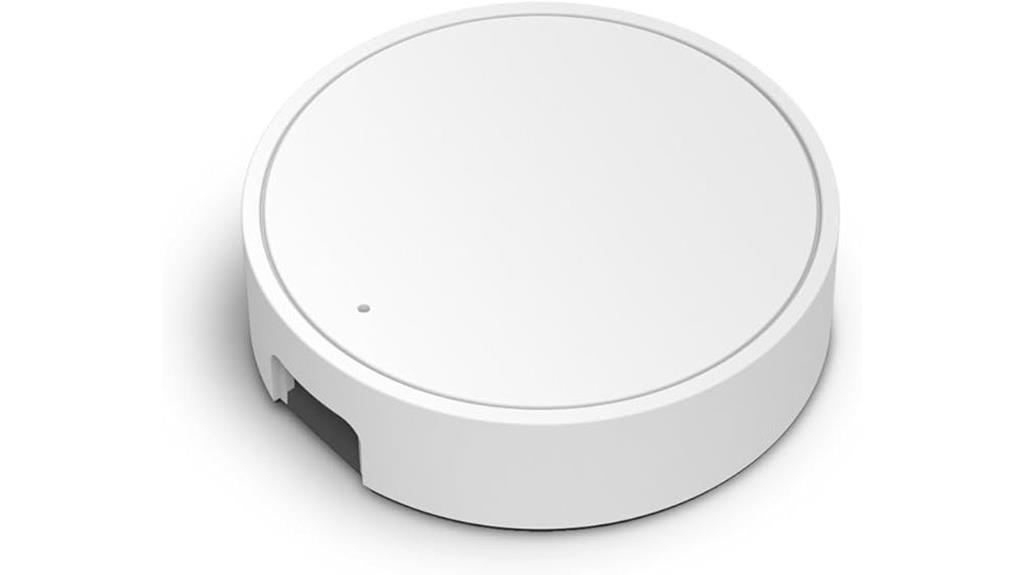
Looking for a compact, reliable hub that seamlessly connects your smart home devices? The Hub Mini Smart Home Hub is a perfect choice. It’s small but powerful, supporting compatibility with Alexa, SmartThings, Philips Hue, Nanoleaf, and Govee. It connects Flic Controllers to your smart devices within a reliable range of up to 50 meters (150 feet). Designed for power efficiency, it enables Flic Controllers to last over two years on a single charge. With ultrafast response times under 0.1 seconds, you’ll experience instant control. Just remember, it requires a Flic Controller, sold separately, to operate.
Best For: smart home enthusiasts seeking a compact, reliable hub to seamlessly connect and control multiple compatible devices with fast response times.
Pros:
- Compact and space-saving design ideal for small spaces
- Supports a wide range of popular smart home platforms including Alexa, SmartThings, and Philips Hue
- Long-lasting power efficiency enabling Flic Controllers to operate over 2 years on a single charge
Cons:
- Requires separate purchase of Flic Controller for functionality
- Limited to a maximum connectivity range of 50 meters (150 feet)
- May need additional setup for optimal integration with certain smart home ecosystems
Aqara Water Leak Sensor 3 Pack
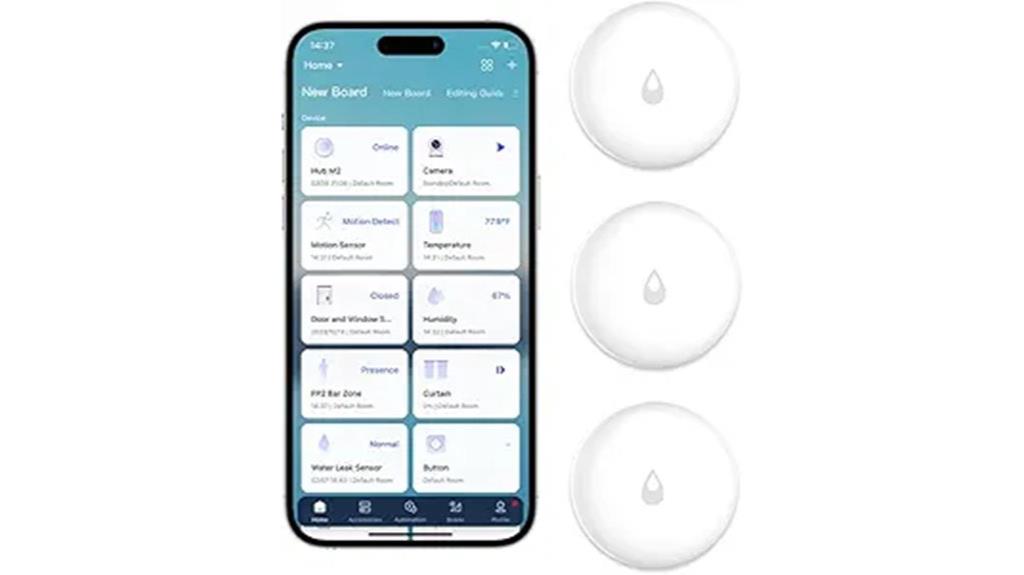
Are you seeking a reliable water leak detection solution that integrates seamlessly with your existing smart home system? The Aqara Water Leak Sensor 3 Pack is an excellent choice. It detects even tiny leaks with highly sensitive probes and instantly alerts you via smartphone or local alarm when water is detected. The sensors are wireless, waterproof, and easy to place near appliances like toilets, water heaters, or sinks. They require the Aqara Hub for operation and work with Apple HomeKit, Google Home, and Alexa within 10 meters. Pairing these sensors with your hub enhances home safety and automation, providing peace of mind against water damage.
Best For: homeowners seeking an easy-to-install, reliable water leak detection system that integrates with popular smart home platforms.
Pros:
- Highly sensitive probes detect water leaks as small as 0.5 mm, preventing undetected damage.
- Wireless and waterproof design allows easy placement near appliances without wiring or screws.
- Compatible with Apple HomeKit, Google Home, and Alexa when paired with Aqara Hub, enabling automation and alerts.
Cons:
- Requires Aqara Hub (sold separately) for operation and automation features.
- Limited to a 10-meter (33 feet) range from the Aqara Hub for stable connection.
- Not compatible with third-party hubs like Zigbee2MQTT, restricting flexibility in hub choices.
AduroSmart ERIA Smart Home Hub/Gateway

The AduroSmart ERIA Smart Home Hub/Gateway is an excellent choice for homeowners seeking a versatile ZigBee controller that integrates multiple smart devices. It supports lights, sensors, plugs, curtains, blinds, thermostats, and locks, all managed via the ERIA app or voice commands through Alexa, Google Assistant, and Apple Shortcuts. While it doesn’t work with Z-Wave, it’s compatible with brands like Hue, IKEA, Sengled, and more. I find it easy to control and automate my home, from adjusting lighting colors to monitoring sensors remotely. Its compact design and straightforward setup make it a reliable hub for seamless ZigBee connectivity in my smart home.
Best For: homeowners seeking a versatile and easy-to-use ZigBee smart home hub that integrates multiple devices and voice assistants for seamless automation and remote control.
Pros:
- Compatible with a wide range of ZigBee devices from popular brands like Hue, IKEA, and Sengled.
- Supports voice control through Alexa, Google Assistant, and Apple Shortcuts for convenient operation.
- Compact design with straightforward setup, making installation simple and unobtrusive.
Cons:
- Does not support Z-Wave devices, limiting compatibility with some smart home ecosystems.
- Customer ratings are mixed, with an average of 3.4 out of 5 stars.
- Limited to ZigBee protocol, which may require additional hubs for Z-Wave or other protocols.
ZigBee 3.0 Hub WiFi & Bluetooth Gateway, Tuya Smart Bridge

If you’re building a smart home with Tuya-compatible devices, the ZigBee 3.0 Hub WiFi & Bluetooth Gateway is an excellent choice because it seamlessly connects most ZigBee and Bluetooth 5.0 devices to your WiFi network. It supports Tuya protocols, enabling easy setup and control via the Smart Life or Tuya Smart App. Compatible with Alexa and Google Assistant, it offers voice control and automation features. Its compact design and stable connection ensure reliable operation. However, it only works with 2.4GHz WiFi and isn’t compatible with non-Tuya devices, so check your device compatibility before purchasing.
Best For: smart home enthusiasts looking for a reliable, easy-to-setup hub to connect Tuya-compatible ZigBee and Bluetooth devices via WiFi.
Pros:
- Supports both ZigBee 3.0 and Bluetooth 5.0, enabling broad device compatibility.
- Easy to set up with straightforward app and Bluetooth pairing process.
- Compatible with Alexa and Google Assistant for voice control and automation.
Cons:
- Only functions with 2.4GHz WiFi networks, requiring users to ensure proper network setup.
- Limited to Tuya-compatible devices; cannot connect non-Tuya protocols or certain device types like door locks or blinds.
- Occasional user reports of glitches, though overall stable performance.
Smart Multi-mode Gateway: ZigBee 3.0 & Bluetooth & Mesh Hub

For homeowners looking to simplify their smart device management, the Smart Multi-mode Gateway with ZigBee 3.0, Bluetooth, and Mesh Hub offers a versatile solution. It supports multiple protocols, allowing you to connect diverse devices like smart lights, sensors, and Finger Bots over a single 2.4GHz network. Integrated with the Smart Life/Tuya App, you can control and organize your devices remotely and set up automation easily. Compatibility with Alexa and Google Home adds voice control. Supporting up to 128 devices within the Tuya ecosystem, this gateway enables seamless whole-house automation, making managing your smart home straightforward and efficient.
Best For: homeowners seeking a versatile, easy-to-manage smart home hub that supports multiple protocols and device types for seamless automation.
Pros:
- Supports multiple protocols (ZigBee 3.0, Bluetooth, Mesh) for broad device compatibility
- Integrates with popular apps and voice assistants for remote and voice control
- Capable of managing up to 128 devices for comprehensive smart home automation
Cons:
- Exclusively compatible with Tuya Smart Devices, limiting third-party device integration
- Requires a stable 2.4GHz network for optimal performance
- May have a learning curve for users unfamiliar with smart home automation systems
Smart Hub Gateway: WI-FI & Zigbee & Bluetooth Mesh Multi-Protocol Communication Gateway

A multi-protocol smart hub gateway is essential for anyone seeking to integrate a wide range of smart devices seamlessly. It supports Zigbee, Bluetooth Mesh, and Wi-Fi simultaneously, making it easy to connect and control up to 128 devices from a single platform. This setup offers a stable, secure connection that’s more reliable than Wi-Fi alone. Using the Smart Life/Tuya App, I can add, reset, and group devices remotely. Plus, with voice control compatibility for Alexa, Google Assistant, and Siri, I can manage my smart home hands-free. It’s an all-in-one solution for unified, efficient, and flexible smart home management.
Best For: homeowners and tech enthusiasts seeking to seamlessly integrate and manage a diverse range of smart devices within a unified, reliable smart home ecosystem.
Pros:
- Supports multi-protocol connectivity with Zigbee, Bluetooth Mesh, and Wi-Fi for versatile device integration
- Compatible with popular voice assistants like Alexa, Google Assistant, and Siri for hands-free control
- Easy device management and automation through the Smart Life/Tuya App with remote access
Cons:
- Limited to supporting up to 128 devices, which may be restrictive for very large smart homes
- Requires compatible smart devices and a stable internet connection for optimal performance
- May involve a learning curve for users unfamiliar with multi-protocol smart hubs and app setup
Aqara Smart Hub M3 for Home Automation

The Aqara Smart Hub M3 stands out as an ideal choice for users seeking a privacy-focused, multi-protocol smart home hub that prioritizes local control. It supports Zigbee, Thread, Wi-Fi, Bluetooth, IR, PoE, and integrates seamlessly with Alexa, Apple HomeKit, and SmartThings. As a Matter controller and border router, it manages up to 127 Zigbee and Thread devices, focusing on local automation without relying on the cloud. With encrypted local storage, flexible placement options, and straightforward setup via the Aqara app, the M3 offers reliable, secure connectivity—perfect for those wanting a robust, privacy-conscious hub that consolidates multiple protocols in one device.
Best For: those seeking a privacy-focused, multi-protocol smart home hub with strong local automation capabilities and seamless integration with ecosystems like Apple HomeKit, Alexa, and Matter.
Pros:
- Supports multiple protocols including Zigbee, Thread, Wi-Fi, Bluetooth, IR, and PoE for versatile device connectivity
- Prioritizes local control and automation, reducing reliance on cloud services for faster, more reliable responses
- Easy setup via Aqara app with Magic Pair technology, and flexible placement options for various home layouts
Cons:
- Limited third-party device compatibility, primarily working natively with Aqara devices
- Range of approximately 60-65 feet may require additional hubs or extenders for larger homes
- App interface is considered chaotic and limited to phones, with some users experiencing bugs and limited device management options
Aqara Smart Hub M2 for Home Automation
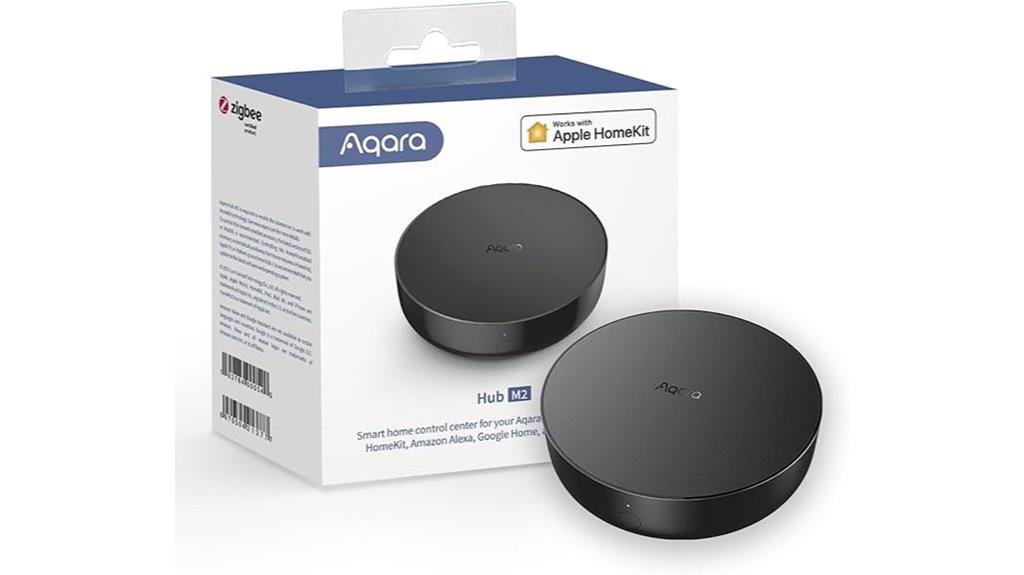
If you’re looking to create a reliable and scalable home automation system, the Aqara Smart Hub M2 stands out with its support for up to 128 Zigbee devices and wired Ethernet connectivity. It requires 2.4 GHz Wi-Fi and connects via an Ethernet RJ45 port for stability and quick response. Compatible with all Aqara Zigbee devices and child devices, it doesn’t support third-party Zigbee or Thread devices. The hub features a built-in speaker for security alerts, alarms, and doorbell functions, plus 360° IR control for managing IR appliances. It integrates seamlessly with major voice assistants like Apple HomeKit, Google Assistant, and Alexa, ensuring versatile ecosystem compatibility.
Best For: homeowners seeking a reliable, scalable, and integrated smart home hub that supports numerous Zigbee devices, with wired Ethernet stability and comprehensive automation features.
Pros:
- Supports up to 128 Zigbee devices for extensive home automation
- Wired Ethernet connection for enhanced stability and quick response
- Built-in speaker for security alerts, alarms, and doorbell functionalities
Cons:
- Does not support third-party Zigbee or Thread devices
- Requires compatible Aqara child devices for full alarm and automation features
- Limited to indoor use due to IR control capabilities
SONOFF Zigbee Bridge Pro Hub, ZigBee 3.0 Smart Gateway

For those seeking a reliable, versatile Zigbee hub that supports extensive device management, the SONOFF Zigbee Bridge Pro Hub stands out. It supports Zigbee 3.0, working seamlessly with SONOFF devices like the ZBMINI-L smart switch and S26R2ZB smart plug. With Wi-Fi and Zigbee dual-protocol support, it guarantees smooth communication across devices. The hub handles up to 128 sub-devices, enabling thorough control through the app. It offers security modes such as home, away, and sleep, functioning as a local alarm even during network outages. Its automation features allow scene linkage and timing, making your smart home more integrated and reliable.
Best For: smart home enthusiasts seeking a reliable, versatile Zigbee hub capable of managing numerous devices with integrated security and automation features.
Pros:
- Supports Zigbee 3.0 protocol for broad device compatibility and seamless connectivity.
- Handles up to 128 sub-devices, allowing extensive smart home setups.
- Functions as a local alarm system with security modes and scene automation, even during network outages.
Cons:
- Requires initial setup and configuration for optimal performance.
- Limited to Zigbee-compatible devices, which may restrict device choices for some users.
- May necessitate a stable Wi-Fi connection for integrated functionalities and app management.
Aqara Smart Hub M3 for Home Automation
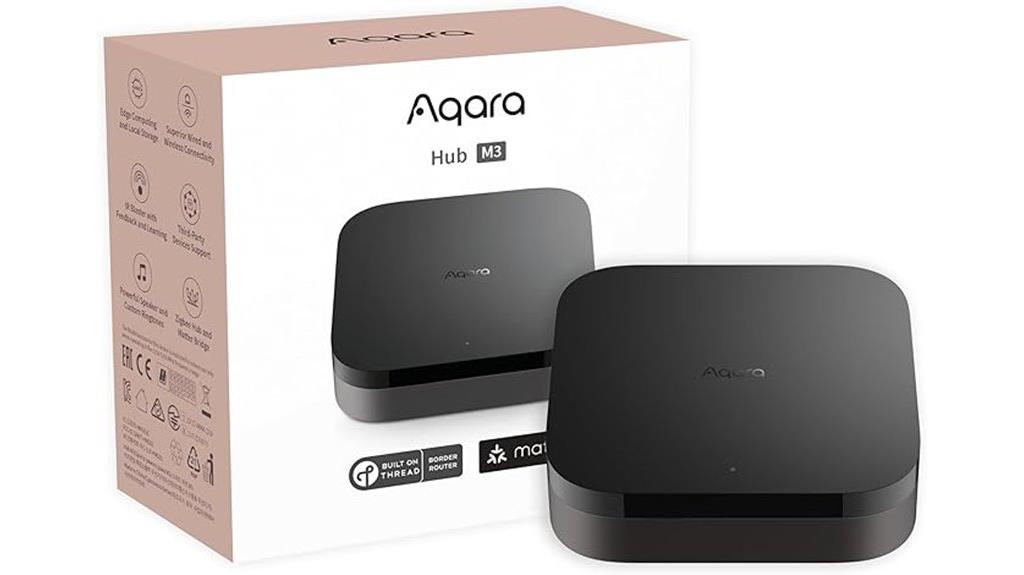
Aqara Smart Hub M3 stands out as an ideal choice for users who prioritize local control and seamless integration within the Aqara ecosystem. It supports Zigbee, Thread, Wi-Fi, Bluetooth, IR, PoE, and popular smart home platforms like Apple HomeKit, Alexa, and SmartThings. Acting as a Matter controller and border router, it manages up to 127 Zigbee and Thread devices, ensuring reliable automation. The hub emphasizes privacy with no microphones or cameras and offers encrypted local storage. Easy setup via the Aqara app makes it perfect for beginners, though its range and app limitations may require additional hubs for larger homes.
Best For: users seeking reliable local control and seamless ecosystem integration within an easy-to-use, privacy-focused smart home hub, especially those invested in Aqara devices and platforms like Apple HomeKit and Alexa.
Pros:
- Supports multiple protocols including Zigbee, Thread, Wi-Fi, Bluetooth, IR, and PoE, enabling versatile device compatibility
- Emphasizes privacy with no microphones or cameras and encrypted local storage, ensuring data security
- Easy setup via the Aqara app with Magic Pair technology, ideal for beginners
Cons:
- Limited range (~60-65 feet), potentially requiring additional hubs or extenders for larger homes
- App interface is chaotic and restricted to mobile devices, limiting multi-user access and advanced customization
- Higher overall cost when factoring in additional extenders or hubs needed for extensive coverage
MOES ZigBee & Bluetooth & Mesh Gateway, Smart Home Hub
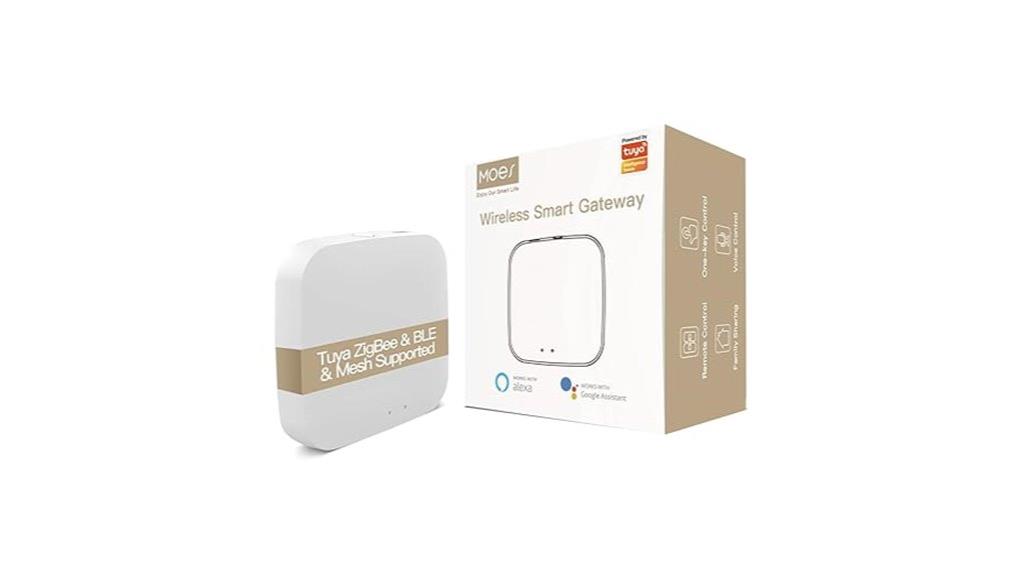
The MOES ZigBee & Bluetooth & Mesh Gateway is an excellent choice for smart home enthusiasts seeking a versatile hub that supports multiple protocols. It handles Zigbee 3.0, Bluetooth mesh (SIG), and supports up to 128 devices, including locks, switches, sensors, and plugs. The device offers security alarms, local automation, and integrates with the Tuya Security SaaS platform. Voice control with Alexa and Google Assistant, plus app remote access, makes managing your devices straightforward. Setup is quick and easy, with minimal wiring required. While some users report device responsiveness issues and limited documentation, overall, it provides reliable connectivity and decent value for multi-protocol smart home integration.
Best For: smart home enthusiasts looking for a versatile, multi-protocol hub that supports Zigbee, Bluetooth mesh, and easy integration with voice assistants and automation platforms.
Pros:
- Supports multiple protocols (Zigbee 3.0, Bluetooth mesh) and up to 128 devices, ensuring broad compatibility.
- Easy setup with minimal wiring, allowing quick integration of devices without technical expertise.
- Integrates seamlessly with popular platforms like Tuya, Alexa, and Google Assistant for convenient control and automation.
Cons:
- Some users experience responsiveness issues with external devices and limited automation capabilities.
- Inadequate documentation can cause confusion around features like remote access and device control.
- Perceived high cost relative to similar Zigbee-only gateways and occasional pairing difficulties with certain devices.
HomeSeer HomeTroller Pi G8 Smart Home Hub
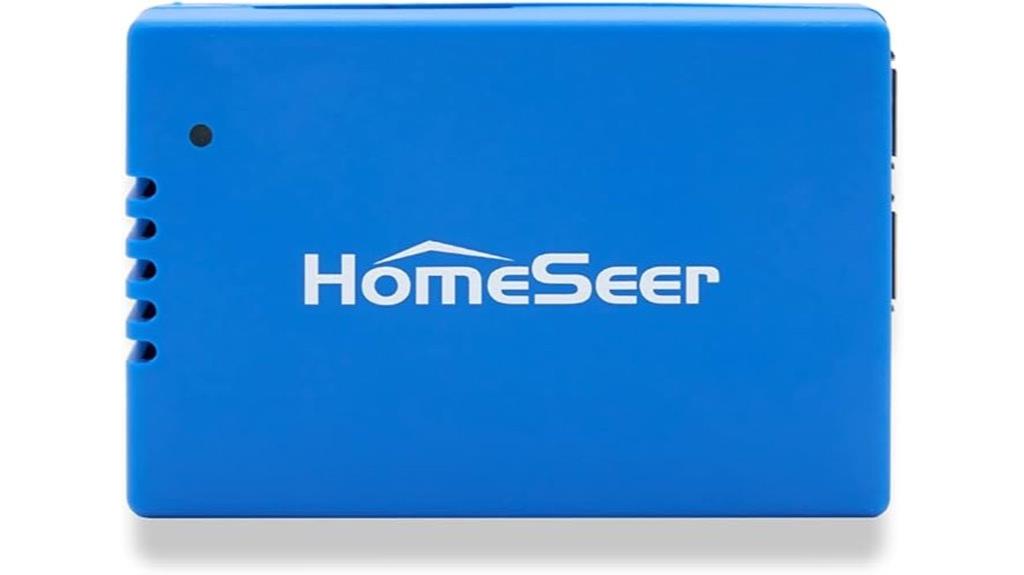
If you prioritize local control and privacy, the HomeSeer HomeTroller Pi G8 stands out as an excellent choice. It manages automations entirely locally, so there are no cloud delays or outages, and all data stays on the hub. Supporting Z-Wave (including Long Range and mesh networks) and Zigbee, it’s compatible with over 7,000 devices via open-source integrations like ZWave JS UI and Zigbee2MQTT. Its powerful hardware—quad-core CPU, 1 GB RAM, and multiple ports—handles complex setups smoothly. Plus, you can control it remotely through the free MyHS app, ensuring seamless access from anywhere while keeping your privacy intact.
Best For: users seeking a privacy-focused, locally managed smart home hub with extensive Z-Wave and Zigbee device support and reliable remote access.
Pros:
- Manages automations entirely locally, ensuring privacy, speed, and reliability
- Supports a wide range of protocols and over 7,000 devices via open-source integrations
- Equipped with robust hardware including a quad-core CPU, ample RAM, and multiple connectivity options
Cons:
- Requires separate Zigbee interface for Zigbee2MQTT support
- Might have a steeper learning curve for advanced customization
- Limited built-in support for some proprietary smart home ecosystems without additional integrations
ZigBee 3.0 Hub WiFi & Bluetooth Gateway, Tuya Smart Bridge

For anyone looking to integrate multiple smart home devices seamlessly, the ZigBee 3.0 Hub WiFi & Bluetooth Gateway, Tuya Smart Bridge, offers a straightforward solution. It supports ZigBee 3.0 and Bluetooth 5.0, connecting most Tuya-compatible devices effortlessly. Easy to set up, it only needs a Micro USB power connection and a few seconds to pair via the app. You can control devices remotely through the Smart Life or Tuya Smart App, and voice commands work with Alexa and Google Assistant. While limited to Tuya products and 2.4GHz WiFi, it provides reliable coverage, automation, and device grouping at an affordable price.
Best For: smart home enthusiasts seeking an affordable, easy-to-set-up hub to connect Tuya-compatible ZigBee and Bluetooth devices using 2.4GHz WiFi.
Pros:
- Supports ZigBee 3.0 and Bluetooth 5.0 for broad device compatibility within the Tuya ecosystem
- Simple setup with minimal wiring, controlled via app, Alexa, and Google Assistant
- Compact size, stable connection, and affordable price point
Cons:
- Limited to Tuya-compatible devices; incompatible with non-Tuya protocols and certain device types like blinds and door locks
- Requires 2.4GHz WiFi; cannot connect to 5GHz networks
- Some users report occasional glitches despite overall positive performance
Sengled Smart Home Hub Z01-hub, Zigbee Smart Products & Bulbs
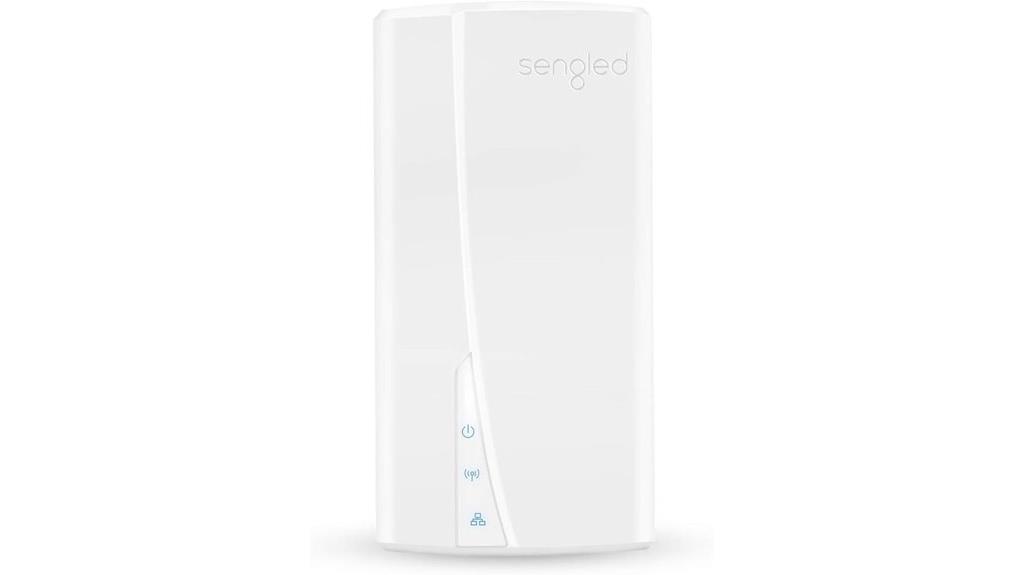
Anyone looking to integrate multiple smart lights and accessories seamlessly will find the Sengled Smart Home Hub Z01-hub an excellent choice, especially since it controls up to 64 devices and supports popular voice assistants like Alexa and Google Assistant. It connects via Ethernet for a reliable setup and pairs easily with the Sengled app. Designed for indoor use, it manages Sengled smart LEDs and accessories, enabling automation, scheduling, and grouping. The included LED bulb offers efficient lighting with a lifespan of around 25,000 hours. Overall, the Z01-hub provides a straightforward, versatile solution for expanding your smart home with Zigbee-compatible products.
Best For: smart home enthusiasts seeking a reliable, scalable hub to control multiple Zigbee-compatible lights and accessories with voice assistant integration.
Pros:
- Controls up to 64 devices, making it suitable for extensive smart home setups
- Compatible with Alexa, Google Assistant, and Sengled app for versatile control options
- Easy Ethernet connection and straightforward setup with in-app guidance
Cons:
- Designed for indoor use only, limiting its placement flexibility
- Customer ratings average around 3.9/5 stars, indicating some users may experience issues
- Limited to Sengled products, which may restrict device variety for some users
Factors to Consider When Choosing a Smart Home Hub Zigbee

When selecting a Zigbee smart home hub, I focus on compatibility with my devices and the protocols it supports. I also consider connectivity options, automation features, and how easy it is to install. These factors help guarantee the hub fits my needs and makes managing my smart home simple.
Compatibility With Devices
Choosing a Zigbee smart home hub requires careful attention to device compatibility to guarantee seamless integration and future expansion. First, I verify the hub supports the latest Zigbee protocol version, like Zigbee 3.0, so my devices stay up-to-date and compatible. I also check if it works with my existing ecosystem, such as Apple HomeKit, Amazon Alexa, or Google Assistant, to avoid integration issues. It’s important to verify whether the hub supports third-party Zigbee devices or is limited to specific brands, which affects my options. Additionally, I consider if it can connect with other protocols like Z-Wave, Thread, or Wi-Fi, for broader compatibility. Finally, I review the maximum number of devices the hub can handle to ensure it can grow with my smart home.
Protocol Support Features
Supporting the latest Zigbee 3.0 protocol is essential because it guarantees my hub can communicate securely and reliably with current devices. This protocol offers improved interoperability, ensuring my smart home devices work seamlessly together. I also need to verify that the hub can handle the maximum number of Zigbee devices I plan to connect, which often ranges from 64 to over 128. Multi-protocol support, like Zigbee combined with Z-Wave, Bluetooth, or Wi-Fi, broadens my device options and simplifies management. Additionally, I look for hubs with firmware that can be updated regularly to support new Zigbee standards and security patches. Compatibility with popular ecosystems such as Apple HomeKit, Amazon Alexa, or Google Home is another critical factor, often requiring specific Zigbee profile support for smooth integration.
Connectivity Options
A smart home hub with versatile connectivity options is vital for guaranteeing my devices communicate reliably. I look for hubs that support multiple methods like Wi-Fi, Bluetooth, and Ethernet to maximize compatibility and stability. Some hubs even integrate Zigbee with protocols like Z-Wave or Thread, expanding device options. Dual-mode hubs that combine Zigbee with Wi-Fi or Bluetooth give me flexible connection choices for different sensors and controllers. Wired connections via Ethernet or USB-C can improve stability and reduce latency, which is essential for seamless operation. Additionally, compatibility with both 2.4GHz and 5GHz Wi-Fi networks ensures smooth integration with my existing network setup. Overall, choosing a hub with diverse connectivity options helps create a reliable, scalable smart home ecosystem.
Automation Capabilities
When evaluating a smart home hub’s automation capabilities, it’s essential to guarantee it can handle complex routines and respond reliably to various triggers. A good hub should support automation rules that activate based on time, device status, or sensor inputs, allowing seamless device interactions. Compatibility with automation platforms like IFTTT, SmartThings, or proprietary apps enhances the ability to create multi-device routines. Supporting local scene and automation execution is vital for reliability during internet outages, ensuring your smart home functions consistently. Multi-protocol support, including Zigbee, Z-Wave, and Wi-Fi, broadens device options and automation scenarios. Advanced features like scheduling, scene creation, and device linking give users customizable, scalable control, making automation more flexible and integrated within their smart home ecosystem.
Installation Ease
Choosing a Zigbee smart home hub that’s easy to install can save you time and frustration. I look for hubs with straightforward setup processes that don’t require extensive wiring or technical skills. A mobile app that guides me step-by-step makes installation smoother and helps avoid mistakes. Clear labeling of ports and simple pairing methods are also essential, especially for those new to smart home tech. Devices that support quick, automatic detection and pairing markedly cut down setup time. Additionally, pre-configured automation templates and guided onboarding features help me integrate and customize my devices efficiently. Overall, a user-friendly installation experience ensures I spend less time troubleshooting and more time enjoying my smart home.
Security and Privacy
Securing your smart home starts with selecting a hub that prioritizes privacy and data protection. Look for hubs supporting strong encryption protocols like AES-128 or WPA3 to protect data during transmission and prevent unauthorized access. It’s also essential that the hub offers local control options, reducing reliance on cloud services and minimizing exposure to data breaches. Regular firmware updates are vital—they patch vulnerabilities and keep your system secure. Additionally, check if the hub can isolate and segment network traffic for Zigbee devices, enhancing privacy by limiting access across your network. Finally, review the manufacturer’s privacy policy carefully. Transparent policies that minimize data collection and sharing demonstrate a commitment to safeguarding your personal information, making your smart home safer and more private.
Ecosystem Integration
To guarantee your smart home hub integrates smoothly with your existing devices, it’s important to contemplate the ecosystems it supports. A compatible hub should work with popular platforms like Apple HomeKit, Google Assistant, Alexa, or SmartThings, enabling seamless communication across devices. Ecosystem compatibility ensures devices from different manufacturers can connect and automate together within the same platform. Supporting protocols like Zigbee, Z-Wave, or Thread broadens the range of third-party devices and sensors you can add. Choosing a hub with open standards or extensive ecosystem support makes device pairing, scene creation, and automation more straightforward. Multi-ecosystem compatibility also future-proofs your setup, allowing flexible device additions and easier upgrades as your smart home evolves. This ensures a cohesive and scalable smart home experience.
Budget Considerations
Budget considerations play a crucial role when selecting a Zigbee smart home hub, especially for those looking to start small or keep costs manageable. Typically, budget-friendly hubs cost under $50, making them ideal for DIY projects or entry-level setups. However, higher-priced hubs usually offer more device capacity, advanced automation features, and better build quality, which can be worthwhile for larger or more complex smart homes. It’s important to take into account the total cost of ownership, including any additional devices or extenders needed to cover bigger areas. Keep in mind that cheaper hubs might have limited compatibility with third-party devices or fewer customization options, affecting long-term flexibility. Balancing features against your budget ensures you get a hub that meets your current needs without paying for unnecessary extras.
Frequently Asked Questions
How Does Zigbee Compatibility Affect Smart Home Device Integration?
Zigbee compatibility makes smart home device integration much smoother because it guarantees all devices can communicate seamlessly within the same network. When devices are compatible, I experience fewer connection issues and easier setup. It also means I can expand my system without worrying about compatibility problems, giving me peace of mind. Overall, Zigbee compatibility simplifies managing multiple devices and enhances the reliability of my smart home ecosystem.
Can These Hubs Operate Independently Without Internet Access?
Yes, many Zigbee hubs can operate independently without internet access. They communicate directly with Zigbee devices through a local mesh network, allowing you to control your smart home even if your internet is down. I’ve tested a few, and I find that local control is reliable and fast. Just keep in mind that some features, like remote access or firmware updates, might require an internet connection.
What Security Features Are Included in These Zigbee Hubs?
I check the security features of Zigbee hubs to guarantee my smart home stays safe. These hubs typically include encryption protocols like AES-128, which protect my data from eavesdropping. They also often support secure pairing methods, device authentication, and regular firmware updates to patch vulnerabilities. Some even offer local control options, so my devices stay secure even if my internet goes down. I feel confident knowing my system is well-protected.
How Scalable Are These Hubs for Expanding Smart Home Systems?
Think of these hubs as the backbone of your smart home, ready to grow with you. They’re highly scalable, easily supporting additional devices as your needs expand without breaking a sweat. You can connect multiple Zigbee devices—lights, sensors, locks—and manage them all effortlessly. This flexibility makes upgrading or enlarging your smart system smooth sailing, ensuring your setup remains as adaptable as your imagination allows.
Which Hub Offers the Best User Interface for Beginners?
I believe the Samsung SmartThings Hub offers the best user interface for beginners. Its intuitive app makes setup straightforward, guiding you step-by-step without technical jargon. I found it really user-friendly, even if you’re new to smart home tech. Plus, its clear visuals and simple controls help you customize your system easily, making it a perfect choice for someone just starting out.
Conclusion
Did you know that Zigbee devices account for over 70% of all smart home products worldwide? Choosing the right hub can make a huge difference in your smart home experience, ensuring seamless connectivity and reliable performance. With options like the Shelly Pro 4PM or the Hub Mini, you’re well on your way to a smarter, more efficient home. Remember, a good hub isn’t just about compatibility—it’s about creating a connected space you love.
